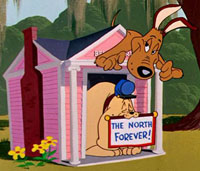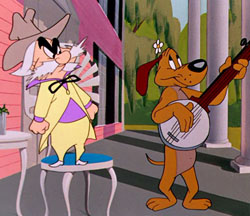
In 1950 Warner Brothers released Chuck Jones’s “Merrie Melodie” episode Dog Gone South. The film stars Charlie Dog as a wandering dog seeking a new owner. He sees potential when he stumbles upon a stereotypical southern colonel’s plantation, but he angers the colonel with references to the North. Also, the colonel already has a bulldog for a pet. For the remainder of the cartoon, Charlie tries to get rid of the bulldog and endear himself to the colonel with such references to the South as “Chitlins forever, y’all!”
 An especially unique aspect of the cartoon is its complete absence of African American characters. Animated films set in the South, especially the Antebellum and Civil War South, contain at least one scene with African Americans, and those characters usually appear as laborers of some sort. Released just one year before Dog Gone South, Jones’s “Bugs Bunny” episode Mississippi Hare opens with faceless African Americans picking cotton (including Bugs’s tail) and loading a steamboat. By 1949 Hollywood’s cartoon divisions had already publicly committed to making fewer films with African American stereotypes, and except for blackface gags in cartoons from Metro-Goldwyn-Mayer, big-lipped and bug-eyed figures had largely disappeared from new animated releases to theatres.
An especially unique aspect of the cartoon is its complete absence of African American characters. Animated films set in the South, especially the Antebellum and Civil War South, contain at least one scene with African Americans, and those characters usually appear as laborers of some sort. Released just one year before Dog Gone South, Jones’s “Bugs Bunny” episode Mississippi Hare opens with faceless African Americans picking cotton (including Bugs’s tail) and loading a steamboat. By 1949 Hollywood’s cartoon divisions had already publicly committed to making fewer films with African American stereotypes, and except for blackface gags in cartoons from Metro-Goldwyn-Mayer, big-lipped and bug-eyed figures had largely disappeared from new animated releases to theatres.
 The appearances of African Americans in South-set films underscore how central African Americans were to the South itself. Nevertheless, the growing strength of the Civil Rights Movement required filmmakers to revise their tropes. If a cartoon could not portray the South humorously without caricaturing African Americans themselves, how would they portray the South?
The appearances of African Americans in South-set films underscore how central African Americans were to the South itself. Nevertheless, the growing strength of the Civil Rights Movement required filmmakers to revise their tropes. If a cartoon could not portray the South humorously without caricaturing African Americans themselves, how would they portray the South?
Dog Gone South addresses the issue by treating ownership of a pet as a proxy of sorts for enslavement of an African American. Two southern colonels discuss trading ownership of Charlie. The dog begs the colonel to be his “massa,” which he says in that exact manner. The studio even chose a brown-colored dog to be the protagonist seeking a master.
Still, Dog Gone South manages to avoid African American images, and it introduces a new way of imaging the South without African Americans. The film serves as a template of sorts for later cartoons that reduce the Civil War to northern figures versus southern ones, such as the studio’s own Rebel Without Claws–just in time for the Civil War Centennial in 1961.
Here are some clips from the cartoon:


 Christopher P. Lehman is a professor of ethnic studies at St. Cloud State University in St. Cloud, Minnesota. His books include American Animated Cartoons of the Vietnam Era and The Colored Cartoon, and he has been a visiting fellow at Harvard University.
Christopher P. Lehman is a professor of ethnic studies at St. Cloud State University in St. Cloud, Minnesota. His books include American Animated Cartoons of the Vietnam Era and The Colored Cartoon, and he has been a visiting fellow at Harvard University.



























One of Chuck Jones’ greatest and most underrated cartoons. Incredibly sharp Michael Maltese dialogue and brilliant Jones poses and expressions. The bit where Charlie stupidly requests yankee pot roast kills me every time. A classic.
Charlie had been the same color since Jones remade Clampett’s “Porky’s Pooch” in 1948 as “Little Orphan Airedale”, so the brown tone here really is just Chuck’s previously-established adaptation for Technicolor (Charlie was white in Clampett’s B&W effort back in ’41).
The main plot point here by Jones and Maltese was trying to use Charlie without Porky, after pretty much burning through that concept with the trio of cartoons made in quick succession, and the decision was made to focus on Charlie’s Brooklyn/Bronx/Jersey accent and pushiness and put him against a character who’d be the most hostile to that type of northern persona. The fact that Charlie ends up being booted back onto the train while Belvidere reunited with the Colonel shows a certain catering to southern audiences of the day that you definitely wouldn’t see 50-70 years later. And three years after that, Yosemite Sam gets out of “Southern Fried Rabbit” probably better than he did in any other cartoon, as the holdout southern soldier who’s now holding the Yankees hostage in Chattanooga (But it also was a really funny end gag).
Always loved this cartoon. Loved the way the Colonel said his lines “Oh, Belvedere! Come heah, boy!” and “Aah, magnolias!”, and cracked up at how Belvedere ran with his back legs in the air, and the grass stain on Charlie’s bottom after getting kicked out.
This would have NEVER happened to Bugs Bunny!
Yes, Charlie Dog looked as he did long before this cartoon was made. And he was as Bronx as Bugs Bunny, “massa” phrase notwithstanding. My impression, based on nothing more than the eyeball test, is that Dog Gone South was produced with little if any consideration for African Americans at all. Maybe early in the story stages it was a thought to avoid any controversy. Neither good nor bad as intent, but just a choice to focus on the Colonel.
In any event, one of Charlie’s very best.
Does it really need to be said that this cartoon was made several decades ago when people thought differently than they do now (well, some people unfortunately think that way, but still…)? At any rate, it’s just as well there are no African American characters in this cartoon, since inevitably they’d have been either a mammy or a laconic Step’n Fetchit. So which is the wronger wrong, putting in the stereotype or leaving out African American characters altogether as if they didn’t exist? Anyway, at least there’s no blackface gag.
Personally, I don’t tune into these classics searching for social, and political commentary. It seems pointless to over analyze, makes more sense to simply enjoy it for what it is: high quality entertainment.
My favorite Charlie Dog short is either “The Awful Orphan” (“G-g-g-get out! Out! OUT! OUT!”) or “A Hound for Trouble” (“You gotta maybe the spaget?”), but “Dog Gone South” is still a fun outing.
The key word here is “massa”. That’s slave dialect, pure and simple. Remember that by 1950, the Daughters of the Confederacy had already spent decades promulgating their view of slavery as an essentially benign paternalism — “lots of food, lot of rest, lots of pampering,” as Belvedere-in-disguise puts it. It was presented as such in history textbooks of that time. Then, too, nostalgic yearning for the “good ol’ days” of the plantation was a very common trope of the “coon songs” of the early 20th century (e.g., Scott Joplin’s “I Am Thinking of My Pickaninny Days” [1902]). Today it would be considered unspeakably monstrous to draw any parallel between African American slaves and household pets, but in the middle of the last century many white Americans would have found it perfectly reasonable — and certainly less controversial than, say, any notion of racial equality.
Recognising this does not make the cartoon any less enjoyable, or any less funny.
The figure of the Southern colonel as a representative of the white Southern ruling class seems to have had its basis in prominent the Southern Congressmen who held powerful committee chairmanships, placed regional interests above those of the nation, stonewalled any civil rights or anti-lynching legislation, and generally got whatever they wanted — cf. Senator Claghorn from the Fred Allen Show (inspiration for the character Foghorn Leghorn). Then there was the Southern colonel who managed Fred Flintstones short-lived career as the rock star Hi-Fye, clearly based on Elvis Presley’s manager Col. Tom Parker (who in actuality was an illegal immigrant from the Netherlands). But the funniest one of all was the Southern colonel in Rocky & Bullwinkle who insisted on changing any mention of the “Civil War” to “War Between the States” — because, as he put it, “I can’t abide that word ‘civil’!”
Thank you. This is excellent.